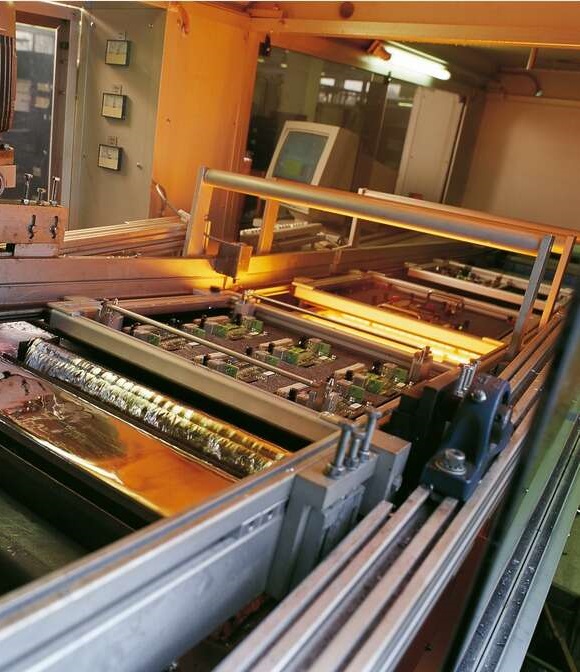Our Facilities


SMT Machine
- Multi-head pick and place SMT Line
- Applicable Components : 0402, 0606, 0805, SOP8, QFN
- Components Supply : Tape reel, Bulk package (IC)Tube
- Tape width : 8mm,12mm,16mm,24mm
- Placement head : 4
- Visual Camera : 6x HD CCD Camera
- Visual Camera (Down) : Automatic identify the mark point
- Visual Camera (Up) : Automatic adjust the offset
- Max applicable PCB : 340*340mm
- Inspection system : Magnifying glass, Temperature controlled solder iron .
- Materials : Alpha solder paste and Wire,PAI-815 Flux.

Stencil Printer
The stencil printer allows the operator to be fast enough to keep up with high-speed pick and place machines without sacrificing precision or accuracy. The printer’s flexibility and ease of use also make it a favorite choice for a variety of production environments.

WAVE SOLDERING
Wave soldering is a large-scale soldering process by which electronic components are soldered to a printed circuit board (PCB) to form an electronic assembly. The name is derived from the use of waves of molten solder to attach metal components to the PCB. The process uses a tank to hold a quantity of molten solder; the components are inserted into or placed on the PCB and the loaded PCB is passed across a pumped wave or waterfall of solder. The solder wets the exposed metallic areas of the board (those not protected with solder mask, a protective coating that prevents the solder from bridging between connections), creating a reliable mechanical and electrical connection. The process is much faster and can create a higher quality product than manual soldering of components.
Wave soldering is used for both through-hole printed circuit assemblies, and surface mount. In the latter case, the components are glued by the placement equipment onto the printed circuit board surface before being run through the molten solder wave.

ESD Flooring
Because electronics can be so sensitive, an inadvertent surge of electricity or exposure to the static charge within a given space can do irreversible damage to expensive equipment or components. Unfortunately, constantly fluctuating electrical charges are simply a part of life. Even as you walk across a room, an electric charge is building between your shoes and the floor. Electronics manufacturers must find a way to regulate these environmental charges to avoid their interfering with daily operations. In addition to damaging equipment, built-up charges can put workers and the facility structure itself at risk. A significant enough buildup of static electricity could result in an electric spark, potentially leading to fire.
To mitigate these potential threats, manufacturers of electronics and semiconductors develop detailed safety plans for the entire facility, starting with the floor. ESD (electrostatic discharge) flooring and conductive floor coatings represent two approved means by which electrostatic discharge can be safely removed from the space. In addition to ESD shoes, wristbands and other wearables, properly grounded equipment, and stringent handling protocols, facilities utilize this specialized flooring as part of their static control safety program. ESD and conductive floors can help direct electrostatic discharge to designated grounding points, thus enhancing an employer’s ability to promote best practices and help safeguard sensitive equipment and personnel.

Infrared Reflow Oven
A SMT reflow oven is an essential machine of the thermal processing of solder for electronics manufacturing. These machines vary in size from small boxy ovens to inline- or conveyor-belt-style options. When an operator places an electronic product inside the device, it precisely applies surface mount components to the printed circuit board (PCB).
The PCB reflow oven has become a staple of the electronics manufacturing industry due to its advantageous size, precision, and speed. Manufacturers can select from various sizes and types, ranging from miniature models to commercial ovens. There are also homemade options, though they have limited functionality and longevity.
These types of machines have become popular because they streamline time and resources consumption. Reflow ovens for PCB assembly represent a significant upgrade over manual soldering of electronic components to PCBs in all measurable values. Plus, they offer high thermal transfer efficiency, more consistent soldering, and even heat distribution.
About Us
SAICA Electronics is a Service provider of all types of PCBA electronic Manufacturering.
Using the very latest electronics manufacturing methodologies, Saica Electronics provides flexible turnkey assembly solutions to niche and high-reliability sectors.
Location
282/1/8, GIDC, Makarpura, Vadodara-
390010, Gujarat, India
Phone
+91-6352559457
info@saicaelectronics.com




